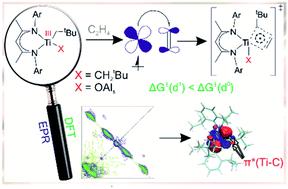当前位置:
X-MOL 学术
›
Chem. Sci.
›
论文详情
Our official English website, www.x-mol.net, welcomes your feedback! (Note: you will need to create a separate account there.)
Molecular and supported Ti(III)-alkyls: efficient ethylene polymerization driven by the π-character of metal–carbon bonds and back donation from a singly occupied molecular orbital
Chemical Science ( IF 8.4 ) Pub Date : 2020-11-11 , DOI: 10.1039/d0sc04436a Anton Ashuiev 1 , Florian Allouche 1 , Nino Wili 1 , Keith Searles 1 , Daniel Klose 1 , Christophe Copéret 1 , Gunnar Jeschke 1
Chemical Science ( IF 8.4 ) Pub Date : 2020-11-11 , DOI: 10.1039/d0sc04436a Anton Ashuiev 1 , Florian Allouche 1 , Nino Wili 1 , Keith Searles 1 , Daniel Klose 1 , Christophe Copéret 1 , Gunnar Jeschke 1
Affiliation

|
While Ti(III) alkyl species are the proposed active sites in Ziegler–Natta ethylene polymerization catalysts, the corresponding well-defined homogeneous catalysts are not known. We report that well-defined neutral β-diiminato Ti(III) alkyl species, namely [Ti(nacnac)(CH2tBu)2] and its alumina-grafted derivative [(AlsO)Ti(nacnac)(CH2tBu)], are active towards ethylene polymerization at moderate pressures and temperatures and possess an electron configuration well-adapted to insertion of ethylene. Advanced EPR spectroscopy showed that ethylene insertion into a Ti(III)–C bond takes place during polymerization from Ti(nacnac)(CH2tBu)2. A combination of pulsed EPR spectroscopy and DFT calculations, based on a crystal structure of [Ti(nacnac)(CH2tBu)2], enabled us to reveal details about the structure and electronic configurations of both molecular and surface-grafted species. For both compounds, the α-agostic C–H interaction, which involves the singly occupied molecular orbital, indicates a π character of the metal–carbon bond; this π character is enhanced upon ethylene coordination, leading to a nearly barrier-less C2H4 insertion into Ti(III)–C bonds after this first step. During coordination, back donation from the SOMO to the π*(C2H4) occurs, leading to stabilization of π-ethylene complexes and to a significant lowering of the overall energy of the C2H4 insertion transition state. In d1 alkyl complexes, ethylene insertion follows an original “augmented” Cossee–Arlman mechanism that involves the delocalization of unpaired electrons between the SOMO, π*(C2H4) and σ*(Ti–C) in the transition state, which further favors ethylene insertion. All these factors facilitate ethylene polymerization on Ti(III) neutral alkyl species and make d1 alkyl complexes potentially more effective polymerization catalysts than their d0 analogues.
中文翻译:

分子和支撑的Ti(III)-烷基:有效的乙烯聚合反应,由金属-碳键的π-字符驱动,并且由单个占据的分子轨道带回
尽管Ti(III)烷基是齐格勒-纳塔乙烯聚合催化剂中建议的活性中心,但尚不清楚相应的定义明确的均相催化剂。我们报道了定义明确的中性β-二亚氨基Ti(III)烷基物质,即[Ti(nacnac)(CH 2 t Bu)2 ]及其氧化铝接枝衍生物[(Al s O)Ti(nacnac)(CH 2 t Bu)],在适度的压力和温度下对乙烯聚合具有活性,并具有非常适合于乙烯插入的电子构型。先进的EPR光谱表明,在从Ti(nacnac)(CH)聚合过程中发生了乙烯插入Ti(III)–C键的过程2吨Bu) 2。基于[Ti(nacnac)(CH 2 t Bu) 2 ]的晶体结构的脉冲EPR光谱和DFT计算的结合,使我们能够揭示有关分子和表面接枝物种的结构和电子构型的详细信息。对于这两种化合物,涉及单个占据分子轨道的α-原子C-H相互作用表示金属-碳键的π特性;乙烯配位后,该π特性得到增强,导致第一步完成后,几乎无障碍的C 2 H 4插入Ti( III)-C键中。在协调过程中,SOMO向π*(C 2 H发生4),导致π-乙烯络合物的稳定化,并显着降低C 2 H 4插入过渡态的总能量。在d 1烷基络合物中,乙烯的插入遵循原始的“增强” Cossee-Arlman机理,其中涉及过渡态SOMO,π*(C 2 H 4)和σ*(Ti-C)之间未配对电子的离域化,这进一步有利于乙烯的插入。所有这些因素促进乙烯在Ti( III)中性烷基上的聚合,并使d 1烷基络合物比其d 0类似物潜在地更有效的聚合催化剂。
更新日期:2020-11-17
中文翻译:

分子和支撑的Ti(III)-烷基:有效的乙烯聚合反应,由金属-碳键的π-字符驱动,并且由单个占据的分子轨道带回
尽管Ti(III)烷基是齐格勒-纳塔乙烯聚合催化剂中建议的活性中心,但尚不清楚相应的定义明确的均相催化剂。我们报道了定义明确的中性β-二亚氨基Ti(III)烷基物质,即[Ti(nacnac)(CH 2 t Bu)2 ]及其氧化铝接枝衍生物[(Al s O)Ti(nacnac)(CH 2 t Bu)],在适度的压力和温度下对乙烯聚合具有活性,并具有非常适合于乙烯插入的电子构型。先进的EPR光谱表明,在从Ti(nacnac)(CH)聚合过程中发生了乙烯插入Ti(III)–C键的过程2吨Bu) 2。基于[Ti(nacnac)(CH 2 t Bu) 2 ]的晶体结构的脉冲EPR光谱和DFT计算的结合,使我们能够揭示有关分子和表面接枝物种的结构和电子构型的详细信息。对于这两种化合物,涉及单个占据分子轨道的α-原子C-H相互作用表示金属-碳键的π特性;乙烯配位后,该π特性得到增强,导致第一步完成后,几乎无障碍的C 2 H 4插入Ti( III)-C键中。在协调过程中,SOMO向π*(C 2 H发生4),导致π-乙烯络合物的稳定化,并显着降低C 2 H 4插入过渡态的总能量。在d 1烷基络合物中,乙烯的插入遵循原始的“增强” Cossee-Arlman机理,其中涉及过渡态SOMO,π*(C 2 H 4)和σ*(Ti-C)之间未配对电子的离域化,这进一步有利于乙烯的插入。所有这些因素促进乙烯在Ti( III)中性烷基上的聚合,并使d 1烷基络合物比其d 0类似物潜在地更有效的聚合催化剂。



























 京公网安备 11010802027423号
京公网安备 11010802027423号